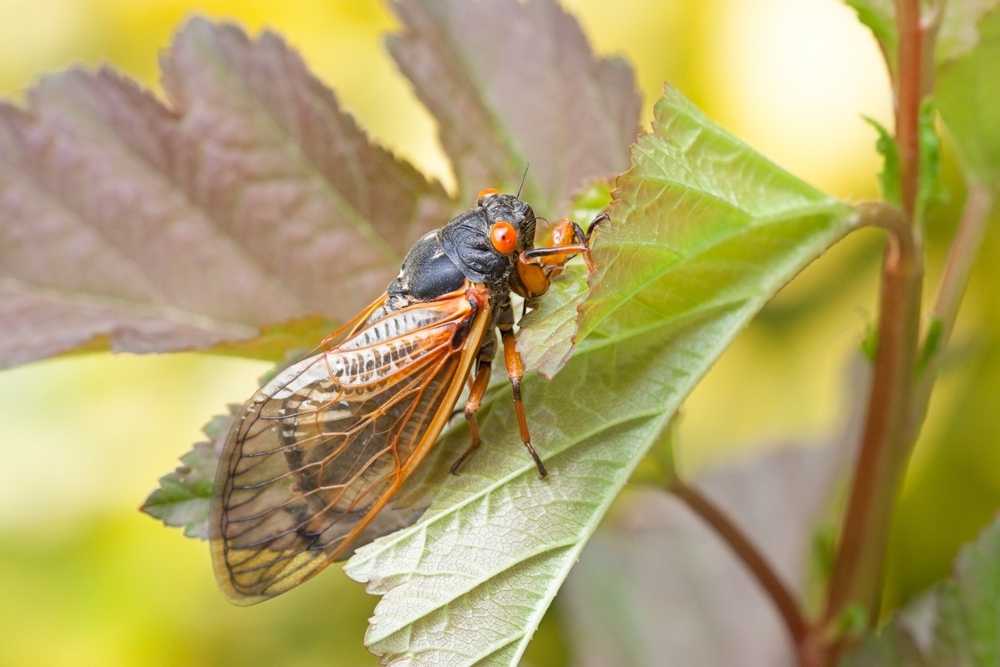6 Ways to Keep Cicadas Away from Your Gutters and House

As cicadas emerge from their underground slumber, homeowners may find themselves bracing for the inevitable invasion of these noisy insects. While their presence is a natural phenomenon, it can pose challenges, especially when it comes to protecting your gutters and home from potential damage and infestations.
Taking proactive measures to keep cicadas away from your gutters and home can help mitigate clogs in your system along with other issues. There are several effective strategies on how to keep cicadas away and safeguard your property. Let’s explore six ways to prepare your gutters and home for cicadas and prevent infestations.
How to Prepare Your Gutters and Property for Cicadas
1. Hire Our Professionals to Perform Extra Gutter Cleanings
Cicadas can pose a unique challenge to gutter systems due to their exoskeletons, which can contribute to clogs when they accumulate in gutters and downspouts. While regular gutter cleanings are essential for maintaining optimal drainage, the increased activity of cicadas during their emergence calls for additional precautions.
Our professionals recommend performing 2-3 gutter cleanings each year under normal circumstances. However, given the expected cicada infestation, it’s advisable to schedule 1-2 extra cleanings this year to ensure that your gutters remain free from debris and cicada remnants. Professional gutter cleaning services can effectively remove any buildup of cicadas and their exoskeletons, preventing potential blockages and preserving the integrity of your gutter system.
2. Trim the Tree Branches Back
Tree limbs and branches serve as pathways for cicadas to access your gutters. By trimming back these branches, you can limit the insects’ ability to reach your gutter system, reducing the risk of clogs and damage. When trimming tree branches, focus on those that overhang or are in close proximity to your roof and gutters.
It’s important to exercise caution or seek professional assistance when trimming branches, especially those at heights, to ensure safety and proper pruning techniques. By maintaining a clear perimeter around your gutters, you can create a barrier that deters cicadas from congregating and potentially causing obstructions.
3. Spray an Insecticide
Applying an insecticide can be an effective method for keeping cicadas away from your gutters. Select a cicada insecticide specifically formulated for cicadas and follow the manufacturer’s instructions for application. It’s recommended to spray the insecticide during early spring and late summer, as these are key periods in the cicadas’ life cycle.
Early spring applications target nymphs emerging from the ground, while late summer treatments address adult cicadas before they lay eggs for the next generation. By strategically timing your insecticide applications, you can disrupt the cicada life cycle and reduce their presence around your home and in your gutters.
4. Use a Hose to Protect Trees and Shrubs
Cicadas are attracted to trees and shrubs for feeding and mating purposes, posing a threat to your landscaping and potentially your gutter system. Using a garden hose to spray down trees and shrubs can create an unfavorable environment for cicadas, deterring them from congregating in these areas.
Focus on thoroughly wetting the foliage, branches, and trunks of susceptible plants to discourage cicadas from settling. Repeat this process as needed, especially during peak cicada activity periods, to maintain the protective barrier around your property and prevent infestations in your gutters.
Read More: Why is It Important to Remove Leaves in Your Gutters?
5. Dispose of Carcasses Immediately
After emerging from the ground, adult cicadas have a relatively short lifespan, during which they mate, lay eggs, and eventually die. The accumulation of cicada carcasses on your property can attract scavengers such as birds and other animals nesting in your gutters, leading to potential blockages and unpleasant odors.
Additionally, the exoskeletons of cicadas can begin to decompose, further exacerbating the situation. To prevent these problems, promptly dispose of cicada carcasses by bagging them and placing them in sealed containers for disposal.
Regularly monitor your property for cicada activity and remove any carcasses to maintain cleanliness and hygiene, reducing the likelihood of attracting unwanted pests and preventing foul odors.
6. Work With an Exterminator
In severe cases of cicada infestation or if preventive measures prove insufficient, seeking professional assistance from an exterminator may be necessary to keep cicadas away from your house. Exterminators have the expertise and resources to effectively control cicada populations and address infestations on your property.
They can assess the extent of the infestation, recommend appropriate treatment options, and implement targeted strategies to mitigate the cicada population’s impact. By collaborating with an exterminator, you can gain peace of mind knowing that your property is being professionally managed, reducing the risk of damage to your gutters and home caused by cicadas.
How Often Do Cicadas Come Out?
Cicadas are known for their distinctive emergence patterns, with different species appearing at intervals ranging from 13 to 17 years. These extended periods of dormancy are a unique phenomenon in the insect world, allowing cicadas to synchronize their life cycles and emerge en masse.
When cicadas do emerge, their presence is often accompanied by a cacophony of loud, buzzing noises as males use their specialized structures called tymbals to produce their characteristic calls. This excess noise can be a defining feature of cicada emergence and is a result of their mating rituals.
What Do Cicadas Look Like?
Adult cicadas are relatively large insects, typically measuring between 2 to 3 inches in length. They have robust bodies with transparent wings and large compound eyes. Cicadas can vary in color depending on the species and geographic location, with common hues including dark green, black, red, and orange. Their striking appearance and loud calls make them a conspicuous presence during their emergence periods.
Why Are Cicadas Emerging in 2024?
The emergence of cicadas in 2024 is due to the lifecycle of specific broods that have been dormant underground for either 13 or 17 years. These broods, which consist of large populations of cicadas, synchronize their emergence to maximize their chances of survival and reproduction.
The timing of cicada emergence is influenced by a combination of environmental cues, including temperature and soil conditions. In 2024, several broods are expected to emerge simultaneously in different regions, resulting in widespread cicada infestations across many states.
Read More: What Are the Main Causes of Leaking Gutters?
Synchronized and Unsynchronized Patterns
Cicada emergence can follow synchronized or unsynchronized patterns, depending on the species and geographic location. Synchronized emergence occurs when large populations of cicadas emerge simultaneously at regular intervals, such as every 13 or 17 years.
In contrast, unsynchronized emergence involves smaller groups of cicadas emerging more frequently, often on an annual basis. These patterns can vary between different broods and species, contributing to the diversity of cicada populations worldwide.
What States Will the Cicadas Emerge in?
In 2024, two significant broods of cicadas are expected to emerge in various states across the United States:
- Brood XIX (19) Great Southern Brood Cicadas: This brood is anticipated to emerge in states including Alabama, Arkansas, Georgia, Iowa, Illinois, Indiana, Kentucky, Louisiana, Maryland, Missouri, Mississippi, North Carolina, Oklahoma, South Carolina, Tennessee, and Virginia.
- Brood XIII (13) Northern Brood Cicadas: This brood is forecasted to emerge in Illinois, Indiana, Iowa, and Wisconsin. Notably, the last time these broods emerged in the same year was in 1803, making the 2024 emergence particularly significant.
With the emergence of two types of broods this year, we recommend working with our professionals to perform a couple of extra gutter cleanings to prevent clogged downspouts, gutters, water damage, and other issues on your property. Our technicians will inspect your gutters to help keep cicadas away from your gutters and house.
Professional Gutter Cleaning and Repair Services
The team at Ned Stevens provides nationwide gutter cleaning and gutter repair services tailored to meet homeowners’ unique requirements. We offer superior gutter cleaning services in Charlotte, NC and other areas across the nation.
With a dedicated team of professionals, we ensure your gutter system remains clean, functional, and prepared to withstand cicadas and any other challenges. Trust Ned Stevens on how to keep cicadas away from your house and for comprehensive gutter care across the United States.


